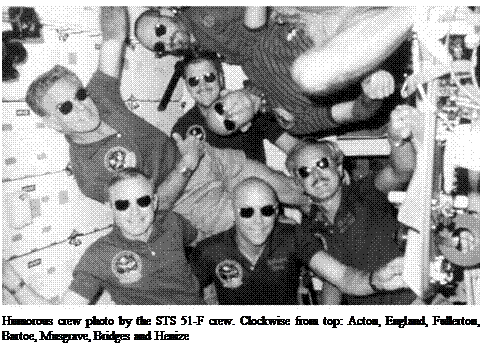STS 51-F
|
Int. Designation |
1985-063A |
|
Launched |
29 July 1985 |
|
Launch Site |
Pad 39A, Kennedy Space Center, Florida |
|
Landed |
6 August 1985 |
|
Landing Site |
Runway 23, Edwards Air Force Base, California |
|
Launch Vehicle |
OV-099 Challenger/ET-19/SRB BI-017/SSME #1 2023; #2 2020; #3 2021 |
|
Duration |
7 days 22 hrs 45 min 26 sec |
|
Callsign |
Challenger |
|
Objective |
Spacelab 2 research programme; verification of Spacelab Igloo/pallet configuration |
Flight Crew
FULLERTON, Charles Gordon, 48, USAF, commander, 2nd mission Previous mission: STS-3 (1982)
BRIDGES, Roy Dunbard Jr., 42, USAF, pilot HENIZE, Karl Gordon, 58, civilian, mission specialist 1 MUSGRAVE, Franklin Story, 49, civilian, mission specialist 2 ENGLAND, Anthony Wayne, 43, civilian, mission specialist 3 ACTON, Loren Wilbur, 49, civilian, payload specialist 1 BARTOE, John-David, 40, civilian, payload specialist 2
Flight Log
The highly esoteric astronomical observation Spacelab 2 science payload had been proposed a decade before and the mission itself had been in preparation for over five years and, at last, 51-F was ready. On 12 July, on Pad 39A all three main engines were up and running with three seconds to go before lift-off, when the hydrogen chamber coolant valve on engine 2 failed to close. A computer ordered a redundant command to be made but mission rules dictated a launch pad abort, called an RCLS abort. As an abort had already occurred on STS 41-D, the event was not greeted with so much drama, although to the crew, which included Karl Henize (who was waiting to be the new oldest man in space after an 18-year wait for a flight), it was a bitter disappointment.
It was also a disappointment to the scientists, because a later launch in less than perfect lighting conditions, as there would be more moon shine, would degrade three of the thirteen primary experiments, mounted on pallets in the payload bay. Challenger tried again on 29 July, and until T + 4 minutes 55 seconds, the launch went well, after a 1 hour 37 minute hold due to incorrect telemetry. The crew had a close eye on the centre engine which was apparently overheating early after lift-off and watched
 |
helplessly as an indicator showed it had shut down, just 33 seconds after Challenger would have had to have performed a transatlantic abort, possibly ditching into the sea and sinking. As it was, an abort-to-orbit was ordered, and at the flick of a switch commander Fullerton initiated a new flight programme. Later, another engine appeared to be overheating and if the crew had not been told to inhibit what was suspected to have been an over-zealous sensor, a worse abort would have resulted.
Challenger struggled into a 49.5° orbit and its OMS engines placed it at a peak altitude of 276 km (171 miles), much lower than had been planned for the Spacelab mission. The use of the OMS engines also restricted flight experiments using the free – flying Plasma Diagnostic Package payload. Nonetheless, the Shuttle had at least reached orbit, in which the busy crew worked in two 12-hour shifts on the vast array of science experiments. These included the Instrument Pointing System (IPS), which did not quite achieve its advertised 1 arc-second of pointing accuracy.
Despite the abort-to-orbit situation, the significant mission re-planning allowed the flight to be deemed a success. As well as verification of the IPS, the flight also featured part of the modular Spacelab system called the Igloo, which was placed at the front of the three-pallet “train” in the payload bay and designed to provide in-flight support to the instruments that were installed on each of the pallets. The main objective of STS 51-F was to verify the Igloo, pallet and IPS system and its interface with the orbiter, in addition to monitoring the immediate environment around the orbiter, which may or may not interfere in the gathering of scientific data. The experiment programme for the flight encompassed life sciences, plasma physics,
astronomy, high-energy astrophysics, solar physics, atmospheric physics, and technology research. This latter category included an evaluation of new beverage containers by the crew. Coke and Pepsi cans, with specially adapted mouth dispensers to both retain the carbonated drinks’ condition and prevent it leaking into the cabin, were evaluated. The system worked but the taste did not, and according to the astronauts who tried the drinks, having extra gas in the digestive system when in space is not the most enjoyable feeling or experience.
Challenger’s performance was so good that an extra day was offered to the crew, which turned it down and came home to runway 23 at Edwards Air Force Base, at T + 7 days 22 hours 45 minutes 26 seconds.
Milestones
108th manned space flight
50th US manned space flight
19th Shuttle flight
8th flight of Challenger
1st Spacelab pallet only science mission
Henize becomes oldest person to fly in space (58)










